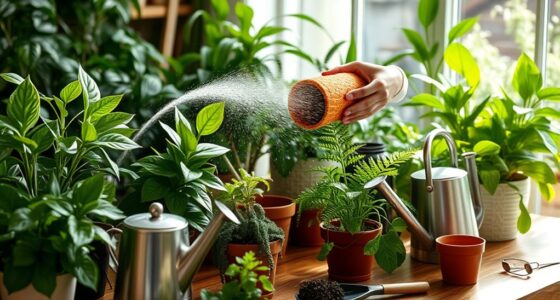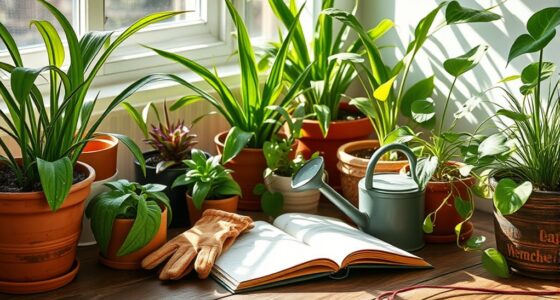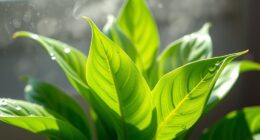To master indoor bonsai, focus on advanced techniques like ensuring proper soil drainage and strategic pruning. Use a well-draining bonsai soil mix with akadama, pumice, and lava rock, and check drainage holes regularly. Prune carefully to shape your miniature tree and remove unhealthy growth, fostering dense foliage. Combining these practices with proper watering and lighting creates a healthy environment. Keep practicing these techniques, and you’ll reveal the secrets to thriving indoor bonsai.
Key Takeaways
- Use well-draining soil mixes like akadama, pumice, and lava rock to prevent root rot and ensure proper water flow.
- Regularly prune to shape the bonsai, remove dead branches, and promote dense, miniature foliage.
- Clear drainage holes and avoid soil compaction to maintain optimal aeration and water drainage.
- Combine pruning with soil management to enhance airflow, health, and overall aesthetic appeal.
- Maintain proper watering, light, and humidity in conjunction with soil and pruning techniques for indoor bonsai success.

Indoor bonsai care requires understanding how to replicate natural conditions within your home. One of the most critical aspects is guaranteeing proper soil drainage. Unlike regular houseplants, bonsai trees need well-draining soil to prevent root rot and maintain healthy growth. You should select a soil mix specifically designed for bonsai, which typically combines akadama, pumice, and lava rock. These components allow excess water to flow freely while retaining enough moisture for the roots. When watering, do so thoroughly until water drains out of the bottom of the pot, guaranteeing the entire root ball receives moisture without suffocating it. Regularly check that the drainage holes are clear and that the soil isn’t compacted, which can impede water flow. Good soil drainage sets the foundation for healthy root development and overall vitality.
Research indicates potential benefits of using specialized soil mixes for optimal bonsai health and growth. Pruning techniques are equally essential in maintaining the miniature aesthetic and health of your indoor bonsai. You need to prune not only to shape the tree but also to promote dense foliage and remove dead or unhealthy branches. Use sharp, clean tools to make precise cuts, and always prune with the plant’s natural shape in mind. Start by trimming back new growth to encourage branching and ramification, which enhances the tree’s miniature scale. When pruning, focus on removing crossing branches or those that grow inward, as these can cause congestion and hinder airflow. Regular pruning also helps control the size of your bonsai, keeping it proportionate and aesthetically pleasing. Remember, the timing of pruning matters; generally, late winter or early spring is ideal for major cuts, while light trimming can be done throughout the year to maintain shape. Combining strategic pruning with proper soil management ensures your bonsai remains healthy and visually appealing.
In addition to soil and pruning, maintaining the right watering schedule, providing adequate light, and controlling humidity are key factors for indoor bonsai success. But mastering soil drainage and pruning techniques forms the core of advanced care. When you pay attention to these details, you create an environment where your bonsai can thrive, grow strong, and develop the intricate beauty that makes these miniature trees so engaging. With patience and precision, you’ll develop a deeper understanding of your bonsai’s needs and be able to shape it into a miniature masterpiece. Your commitment to these advanced care techniques ensures your bonsai remains vibrant, healthy, and a true reflection of your dedication and skill.
Frequently Asked Questions
How Can I Prevent Pests on My Indoor Bonsai?
To prevent pests on your indoor bonsai, you should implement pest prevention strategies like regularly inspecting your tree and keeping its environment clean. Use natural pest repellents such as neem oil or insecticidal soap to deter unwanted bugs without harming your bonsai. Maintain proper watering and airflow, and isolate new plants before introducing them. These steps help keep pests at bay and ensure your miniature tree stays healthy.
What Are Signs of Overwatering in a Bonsai?
Imagine your bonsai’s roots drowning in a swamp—overwatering often leads to root rot, signaling trouble beneath the surface. You’ll notice leaves turning yellow or dropping prematurely, like autumn’s first whisper. If your tree’s soil stays soggy and leaves fall without reason, overwatering’s the culprit. To save it, let the soil dry out between waterings, and guarantee proper drainage, giving your miniature tree room to breathe and thrive.
How Do I Prune for Optimal Miniature Growth?
To prune for ideal miniature growth, start with careful branch trimming to shape the tree and remove dead or crossing branches. Incorporate root pruning during repotting to control size and encourage healthy growth. Keep your cuts precise, and avoid over-pruning, which can stress the tree. Regularly monitor the tree’s response, adjusting your pruning techniques to promote dense foliage and a balanced, miniature form.
What Is the Best Fertilization Schedule for Indoor Bonsai?
You should follow a fertilization schedule that considers fertilizer types and nutrient timing. Use a balanced, water-soluble fertilizer every 2-4 weeks during the growing season, and reduce feeding in winter. Focus on nitrogen-rich formulas in spring and summer for healthy growth, then shift to phosphorus and potassium in fall. This approach guarantees your indoor bonsai gets the right nutrients at the right time, promoting vibrant, miniature growth.
How Do I Repot a Bonsai Without Stressing the Tree?
When wondering how to repot a bonsai without stressing the tree, remember gentle, guiding techniques. Start with careful repotting techniques, gently removing the old soil. Trim roots thoughtfully, focusing on healthy, thick roots while avoiding over-trimming. Water well before and after repotting, and choose a calm, cool time for the process. This approach minimizes stress, ensures healthy growth, and helps your miniature marvel thrive in its new home.
Conclusion
By mastering advanced indoor bonsai techniques, you unveil the true potential of your miniature trees. For example, imagine carefully adjusting watering schedules and pruning methods, resulting in a healthier, more vibrant bonsai that becomes a stunning centerpiece. Remember, patience and attention to detail are key. With dedication, you’ll not only nurture a beautiful tree but also develop a calming, rewarding hobby that deepens your connection to nature. Keep practicing, and watch your bonsai flourish.










